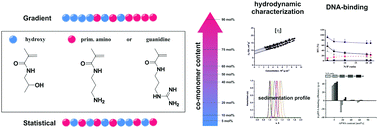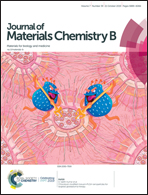The influence of gradient and statistical arrangements of guanidinium or primary amine groups in poly(methacrylate) copolymers on their DNA binding affinity†
Abstract
Herein, we report the first gradient guanidinium containing cationic copolymers and investigate their binding ability to plasmid DNA (pDNA). To understand the effect of different charge distributions and cationic charge sources (primary amines vs. guanidinium group) on (pDNA) binding affinity, we synthesized a library of well-defined statistical cationic copolymers comprising N-(2-hydroxy-propyl)methacrylamide (HPMA) and N-(3-aminopropyl)methacrylamide (APMA) or N-(3-guanidinopropyl)methacrylamide (GPMA) and compared them with gradient polymers containing the same monomers of similar composition. All copolymers were synthesized through aqueous reversible addition–fragmentation chain transfer (aRAFT) polymerization at various monomer ratios by aiming at similar molar masses with low dispersity indices. For the molar mass characterization, in addition to size exclusion chromatography with two different systems, hydrodynamic characterization utilizing analytical ultracentrifugation, viscometry, and accompanied density measurements was conducted. pDNA was used as a model drug to demonstrate the impact of copolymer architecture on binding efficiency. For both HPMA–APMA and HPMA–GPMA copolymers, the gradient distribution demonstrated superior binding and denser packing of pDNA than their statistical counterparts at 20% and lower cationic charge contents. With respect to charge origin, the guanidinium group represented a higher binding efficiency than primary amines with the same nitrogen to phosphate ratio (N/P ratio). Our study demonstrates the profound effect of gradient monomer arrangement on the ability of polyplex formation and reveals the potential for further investigation in gene delivery applications. Gradient guanidinium containing copolymers have great promise for gene delivery applications due to their high affinity toward pDNA even at very low degrees (<20%) of charged monomer content.



 Please wait while we load your content...
Please wait while we load your content...